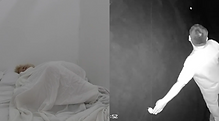Permiso para Disparar, 2019
%2017_11_35.png)
%2016_49_05.png)


This piece is based on the book 'The Woman Who Looks at Men Who Look at Women' by Siri Hustvedt. It explores ideas from Susan Sontag about the distance from the body for the production of desire, as well as concepts of Jacques Derrida's 'trembling' regarding the performativity of the body's involuntary impulses resulting from experiencing an event that generates post-traumatic stress
In the space before entering the installation, a sign stops the viewer, stating, "I invite you to respect my privacy. Please enter this space one at a time" The observer understands the premise and enters alone into a black room illuminated by a dim light. The first impression is of a black cube in the middle of the room, approximately 2m x 2m x 2m.


The light guides the way to the only opening on one of the sides. Entering through this opening, one finds themselves in a smaller space where it becomes evident that the original cube is completely divided into two equal rectangles, each measuring 2m x 1m. Only one side can be accessed by the observer, and the other is completely inaccessible.
In this dark space, there is only a switch on the left side of the panel that divides both areas. The scenario suggests pressing the switch, which immediately allows light to pass through a peephole on the right side of the same panel (1.5m away from the person standing). The viewer realizes that by continuously pressing the switch, they illuminate the inaccessible space; once they stop pressing, it turns off again.
When attempting to observe through the small hole, it becomes clear that pressing the switch and looking through it at the same time is impossible due to the distance between them. The viewer decides to leave the space and invites an accomplice, breaking the premise of entering alone.
The presence of the two visitors now carries a voyeuristic connotation: one peeks through the hole, while the other presses the switch to keep the inaccessible side visible. After that, they change positions.
Through this hole, they can see a reflection of a mirror at a 45-degree angle to the floor, projecting the image of the performer sleeping. This establishes a direct dialogue among observers and her vulnerable space, capturing involuntary tremors resulting from their experiences with abuse—tremors that were initially conceived as impossible to be seen if the premise was followed.
We rely on these layers to connect the gaze to cultural and linguistic structures. This situation prompts us to question the conventional passive-abusive attitude of individuals within our society that silently affects the collective unconscious.
%201.jpg)